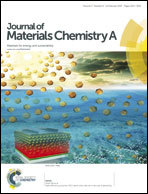A three-dimensional conducting oxide hollow nanobead photoanode: synthesis, characterization, and applications in dye-sensitized solar cells†
Abstract
It was reported that liquid-electrolyte-based dye-sensitized solar cells (DSSCs) are “majority carrier” devices where the internal electric field is screened off; accordingly, the electrons travel through the TiO2 nanoparticles by diffusion rather than drift, resulting in “sticky” electrons which undergo frequent trapping and detrapping. We report here the drift transport observed in I−/I3− electrolyte-based DSSCs by using a 3-dimensional (3-D) transparent conducting oxide (TCO) such as fluorinated tin oxide (FTO) coated with TiO2 as the photoanode. By re-allocating the charge transport process, the thin TiO2 layer (20–30 nm) covering the entire TCO scaffold leads to a striking reduction in charge transport distance by a factor of 102 to 103. Electrochemical impedance spectroscopy (EIS) study indicates that it is viable to establish a potential gradient in the 3-D TCO scaffold; thus, the electron transport in this 3-D TCO structure exhibits field-driven drift behaviour, which is verified by the linear dependence of electron lifetime on the photovoltage, along with the virtual independence of electron transport resistance with respect to the bias voltage in spite of the use of the liquid I−/I3− electrolyte.


 Please wait while we load your content...
Please wait while we load your content...